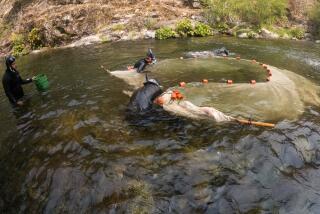Farmers, Officials OK Creek Plan
- Share via
Ending years of bitter legal wrangling, Camarillo farmers, Thousand Oaks city officials and local water agencies have reached an agreement on a plan to divert water from Conejo Creek.
Farmers and water officials said Tuesday the plan would help conserve drinking water throughout Ventura County by making it easier for farmers to use treated waste water for irrigation.
“It results in more water being used at lower cost by more farmers,” said David A. Lamb, an attorney for several Camarillo-area farmers.
Conejo Creek, composed mostly of treated discharge from Thousand Oaks’ Hill Canyon Waste Water Treatment Plant, now flows into Calleguas Creek and Mugu Lagoon, and finally into the Pacific Ocean.
But the city wants to sell the reclaimed water to agencies that could then build a diversion plant west of the Conejo Grade, sending the water through pipes to farmers on the Oxnard Plain.
Farmers who owned land along the creek fought the diversion plan in the late 1980s, and sued to stop it in the early 1990s. Those farmers had pumped water from the creek on their own for years to irrigate crops, and they feared that the diversion project would deprive them of a cheap and plentiful water supply.
Tuesday, however, the farmers cautiously praised the revised plan, described in a draft environmental impact report released this week by the city of Thousand Oaks.
“It’s certainly better than nothing,” said Fitzgerald Ranch owner Gerald Fitzgerald, who grows 250 acres of lemon, avocado and lettuce fields along Conejo Creek. “Since 1989, we’ve been arguing about this situation,” he said.
Thousand Oaks issued a draft environmental report on a Conejo Creek diversion project in May, 1991, and certified a final report in January, 1992.
Farmers sued to stop the project, winning in Ventura County Superior Court in December, 1992, but losing an appeal in August, 1994.
Meanwhile, a new general manager of the Camrosa Water District was working behind the scenes to resolve the matter.
“We took kind of a fresh look, because we had no history here and no baggage,” said Richard H. Hajas, the manager who served as mediator. “When I came here, everyone was posturing for a fight. We just spent a lot of time trying to find out what people’s issues were and trying to get through years of mistrust.”
The result is the significantly modified project described in the new environmental impact report.
The first incarnation of the project sent most of the diverted water to the Pleasant Valley County Water District, farther west, leaving the farmers along the creek high and dry. The revised project provides the majority of the diverted water to Camrosa, which in turn will supply the same farmers who once pumped water from the creek themselves.
Lamb called the new plan “a vast improvement from the prior project.”
Farmers had been concerned that the cost of purchasing water, instead of pumping it themselves, would put them out of business or force them to sell their property to developers. But most now say the cost of reclaimed water is low enough that it will allow them to continue to use their land for agriculture.
The plan would bring reclaimed water to more farms, some of which now use wells for irrigation. The well water could be used to expand the drinking supply.
Donald H. Nelson, Thousand Oaks’ director of public works, said he hoped the diversion would begin operation in the summer of 1997. The city is accepting public comments on the environmental impact report until May 18, and will then apply to the State Water Resources Control Board for the rights to divert the water.
Concerns were raised that diverting as much as 3.25 billion gallons of water a year from the creek might harm rare wildlife that inhabit its shores. But a search for California red-legged frogs along the creek last month was unsuccessful, and the environmental impact report on the project released this week, and authored by a consultant to the city, found there are no significant environmental impacts that cannot be completely mitigated.
More to Read
Sign up for Essential California
The most important California stories and recommendations in your inbox every morning.
You may occasionally receive promotional content from the Los Angeles Times.













